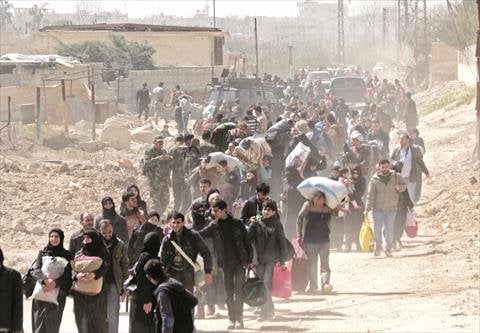After the 4th Astana conference, the largest demographic change during 2 months ends with the displacement of more than 120000 people towards Afrin and the Syrian north
Since the 13th of March 2018, the displacement operations started in the Syrian interior, the start of which was in al-Kadam neighbourhood south of Damascus, then the displacement operations came one after the other according to deals and agreements between representatives of the areas in which the displacement took place and its factions; and between the Russians and the regime. These agreements have completed two consecutive months and included al-Kadam neighbourhood south of the capital Damascus then the Eastern Ghouta, a part of Yarmouk Camp, the towns of Yalda, Babbila and Beit Saham south of Rif Dimashq, towns and villages of Jiroud, al-Dumayr, al-Rahiba, Nasiriyah and Atnah in the Eastern Qalamoun, the northern countryside of Homs and the southern countryside of Hama, where the most significant displacement in Syria was completed during two consecutive months, after the Astana conference and decreasing the combat operations, and the buses did not stop transporting the displaced people from the aforementioned areas to the northeastern countryside of Aleppo, Afrin area and Idlib Province.
The Syrian Observatory for Human Rights monitored the number of people who came out of each area, where the total number of people who got out of their areas to the Syrian north reached about 120100 displaced people from in the Eastern Ghouta, south Damascus, south Rif Dimashq, Eastern Qalamoun, northern countryside of Homs and southern countryside of Hama. The number of displaced people of the Eastern Ghouta reached about 68700 displaced people, followed by the displacement operation from central Syria -north Homs and south Hama- which included about 34500 displaced civilians, fighters and their families, followed by the south of Rif Dimashq by 9270 displaced persons, while about 1460 were displaced from al-Kadam neighborhood and part of al-Yarmouk Camp of fighters and civilians, while about 6240 civilians and fighters have been displaced from the Eastern Qalamoun, also hundreds of thousands of civilians remained in the areas where the displacements took place after accepting the “settlement with the regime” with a Russian guarantee, and in accordance with conditions that have been signed by the people.
The Syrian Observatory for Human Rights monitored the arrival of largest part of the displaced people to Afrin area, from which hundreds of thousands of its people have been displaced by “Olive Branch” operation, and tens of thousands of them have been resettled in houses of civilian and farms, and in camps in the southwestern countryside of Afrin, while the other part remained in the northern countryside of Aleppo and in Idlib Province, where some of them refused to be settled by the Turkish authorities and the factions in Afrin area, they also refused to live in homes where its people have been displaced, where the Syrian Observatory for Human Rights monitored over the past few days that the Turkish authorities resettled the displaced people of the Eastern Qalamoun and the Eastern Ghouta in Afrin area, after displacing hundreds of thousands of civilians out of it, by the military operation carried out by the Turkish Forces and the Syrian rebel and Islamic factions of the “Olive Branch” Operation, which was launched on the 20th of January 2018 until the 18th of March of the same year, where they completed on Sunday the 29th of April 2018, 6 weeks of controlling the entire area of Afrin, after an intense aerial and ground bombardment that left some 300 civilian casualties in addition to hundreds of wounded and also destroyed property of civilians, public facilities and infrastructure in the villages and towns of Afrin area and Afrin city, the SOHR also monitored the Turkish authorities operating in Afrin area taking the data of people entering Afrin area, particularly the displaced people of the Eastern Ghouta, where their fingerprints and eye prints of the inhabitants of the area are recorded, as well as the full information about them, amid strict procedures for those entering and exiting the area, in addition to stopping and inspecting inhabitants of the area and those who remained and refused to get out of it, where they were searched, scrutinized and interrogated during their movement on the checkpoints of Afrin areas.

